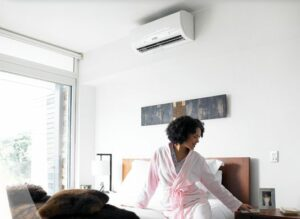We love our pets—the unconditional love, playful companionship, and the quirky little traits defining their individual, lovable personalities. In the United States, 36.5% of households own a dog and 30.4% own a cat, according to the American Veterinary Medical Association (AVMA). That’s about 79.5 million homes with a dog or cat living in it. Plus, another 3.7 million homes with a bird, which is also considered a “companion animal” in the AVMA statistics.
All these companion animals have another thing in common—they all have allergy-triggering dander. A lot of customers ask me about the best air filter for allergies, but my answer is always longer than they expect because the solution to an allergy-friendly house doesn’t stop at a HEPA filter.
Here is my 4-step strategy for making everyone with allergies more comfortable in your home.
Why Are People Allergic To Pets?
I’m not a doctor, but I read about their studies, and the proteins found in dander, skin flakes, saliva, urine, and feces can trigger allergic reactions and aggravate asthma symptoms, according to the American Academy of Allergy, Asthma & Immunology. Plus, pet fur can also carry such environmental allergens as pollen and mold spores.
Pet fur and feathers, as well as excrement, can easily be cleaned and removed from the home. However, microscopic particles go airborne and aren’t as easily seen or removed.
1. Start by Limiting the Dander. 
You should consult your veterinarian before starting any treatments on your pet. The best way to care for your pet in order to reduce allergens depends on the type and breed of pets you own, as well as whether they live indoors, outdoors, or both.
Some sort of grooming typically reduces pet dander so it’s a good idea to ask:
- How can my pet be groomed to limit dander and fur?
- What’s the best way to brush and wash my pet to limit dander?
2. Furnish and Clean Your Home With Purpose.
Frequent cleaning removes dander once it’s in your home, according to The Humane Society. However, vacuuming stirs up dander, dust mites, and other allergens, so it’s a good idea to have a HEPA filter on your vacuum. Don’t forget to wipe down furniture, windowsills, and any flat surface, as well as shake out rugs outside. Wash pillows, blankets, and especially pet beds.
To ease the cleaning workload, decorate your home with furnishings that don’t collect a lot of pet hair, and try to limit wall-to-wall carpeting.
3. Remove Dander and Allergens From the Air.
Airborne allergens are very stubborn. Cat dander can stay airborne longer than dust mites and can take up to 30 weeks to dissipate to levels found in animal-free homes, according to the American College of Allergy, Asthma & Immunology.
Find quality HEPA filters for your HVAC system and vacuum. HEPA is an acronym for “high-efficiency particulate air.” This type of mechanical air filter forces air through a fine mesh that can trap such pollutant particles as pollen, pet dander, dust mites, and even tobacco smoke, according to WebMD.
The Humane Society suggests making a pet-free area, possibly a bedroom. In rooms like this where you want extra filtration, you may want to install a ductless mini-split, with a HEPA filter, to add another layer of focused purification.
You won’t have to look hard to find a wide selection of air purification choices. Today’s leading HVAC manufacturers combine all the latest technologies to meet consumer demand for turnkey HVAC systems that are quiet, conveniently sized, and energy efficient while providing:

- Air cleaners to remove such pollutants as dust, pollen, mold spores, bacteria, and viruses
- Humidity controls eliminate mold and stagnant odors
- UV lamps to keep the interior of the unit free from mold and bacteria
4. Clean Your HVAC System.
This is one of the easier cleaning tasks! If you have floor vents, vacuum them as often as you clean the rest of the house. Find a suitable attachment to remove all the trapped pet fur, grit, and dust.
Once a month, check the air filter for gritty buildup and fur. A clogged air filter inadequately purifies the air and reduces the energy efficiency of your HVAC equipment. Left unchanged, a simple clogged filter can cause catastrophic failures.
If you have a central heating & cooling system, you may want to clean out your ductwork. However, don’t rush in! The Environmental Protection Agency warns: if done improperly, cleaning ductwork can stir up and send massive amounts of allergens into your home. It’s actually not the pet dander that you need to look out for in your ductwork—it’s mold.
Cleaning up the mess from cleaning your ductwork the wrong way isn’t worth the risk. Take the time to find the best air-systems cleaning specialists for advice on cleaning your ducts or simply call us.
Phil
CPS Heating and Cooling
You can always call on your extended family of dependable heating, cooling, and air quality experts at CPS Heating & Cooling.


